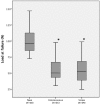Introduction of a new repair technique in bony avulsion of the FDP tendon: A biomechanical study
- PMID: 29967345
- PMCID: PMC6028643
- DOI: 10.1038/s41598-018-28250-y
Introduction of a new repair technique in bony avulsion of the FDP tendon: A biomechanical study
Abstract
The purpose of this study was to determine the biomechanical characteristics of an innovative surgical technique based on a tension banding principle using a suture anchor in the repair of bony avulsions of the flexor digitorum profundus tendon. After injury simulation in 45 fresh frozen distal phalanges from human cadavers, repair was performed with minifragment screws, interosseous sutures and the innovative technique (15 per group). All repairs were loaded for a total of 500 cycles. Subsequently the specimens were loaded to failure. Load at failure, load at first noteworthy displacement (>2 mm), elongation of the system, gap formation at the avulsion site, and the mechanism of failure were assessed. The new techniques' superior performance in load at failure (mean: 100.5 N), load at first noteworthy displacement (mean 77.4 N), and gap formation (median 0 mm) was statistically significant, which implies a preferable rigidity of the repair. No implant extrusion or suture rupture during cyclic loading were recorded when the new technique was applied. This innovative repair technique is superior biomechanically to other commonly used surgical tendon reattachment methods, particularly with respect to an early passive mobilisation protocol. Further, due to its subcutaneous position, reduction of complications may be achieved.
Conflict of interest statement
The authors declare no competing interests.
Figures







Similar articles
-
A suture anchor-based repair technique for type IV jersey finger injuries: a biomechanical investigation.Sci Rep. 2023 Mar 1;13(1):3493. doi: 10.1038/s41598-023-30373-w. Sci Rep. 2023. PMID: 36859502 Free PMC article.
-
Biomechanical characteristics of suture anchor implants for flexor digitorum profundus repair.J Hand Surg Am. 2014 Feb;39(2):256-61. doi: 10.1016/j.jhsa.2013.11.023. J Hand Surg Am. 2014. PMID: 24480686
-
Comparison of an all-inside suture technique with traditional pull-out suture and suture anchor repair techniques for flexor digitorum profundus attachment to bone.J Hand Surg Am. 2013 Jun;38(6):1084-90. doi: 10.1016/j.jhsa.2013.02.015. Epub 2013 Apr 9. J Hand Surg Am. 2013. PMID: 23578439 Free PMC article.
-
A Meta-Analysis of Biomechanical Studies for Suture Button Pullout Versus Suture Anchor Repair of Flexor Digitorum Profundus Avulsions.Hand (N Y). 2024 Jun;19(4):671-678. doi: 10.1177/15589447221126760. Epub 2022 Oct 5. Hand (N Y). 2024. PMID: 36196928 Free PMC article.
-
The Accommodation of Bone Anchors Within the Distal Phalanx for Repair of Flexor Digitorum Profundus Avulsions.J Hand Surg Am. 2019 Nov;44(11):986.e1-986.e6. doi: 10.1016/j.jhsa.2018.12.012. Epub 2019 Feb 15. J Hand Surg Am. 2019. PMID: 30777399 Review.
Cited by
-
FDP avulsion: A washer technique.JPRAS Open. 2020 Nov 21;27:40-43. doi: 10.1016/j.jpra.2020.11.005. eCollection 2021 Mar. JPRAS Open. 2020. PMID: 34258364 Free PMC article.
-
A suture anchor-based repair technique for type IV jersey finger injuries: a biomechanical investigation.Sci Rep. 2023 Mar 1;13(1):3493. doi: 10.1038/s41598-023-30373-w. Sci Rep. 2023. PMID: 36859502 Free PMC article.
-
Characteristics and Therapy of Jersey Finger Type V Injuries at a Middle-European Level 1 Trauma Center-A Retrospective Data Analysis.J Clin Med. 2024 Oct 31;13(21):6540. doi: 10.3390/jcm13216540. J Clin Med. 2024. PMID: 39518678 Free PMC article.
-
Hook Plate as a Treatment for Flexor Digitorum Profundus Avulsion Types II and III.Hand (N Y). 2021 Jul;16(4):551-556. doi: 10.1177/1558944720957730. Epub 2020 Sep 16. Hand (N Y). 2021. PMID: 32935573 Free PMC article.
References
-
- McMaster PE. Tendon and muscle ruptures: Clinical and experimental studies on the causes and locations of subcutaneous ruptures. J Bone Joint Surg. 1933;15:705–722.
-
- Leddy JP. Avulsions of the flexor digitorum profundus. Hand Clin. 1985;1:77–83. - PubMed
MeSH terms
LinkOut - more resources
Full Text Sources
Other Literature Sources
Medical
Miscellaneous

